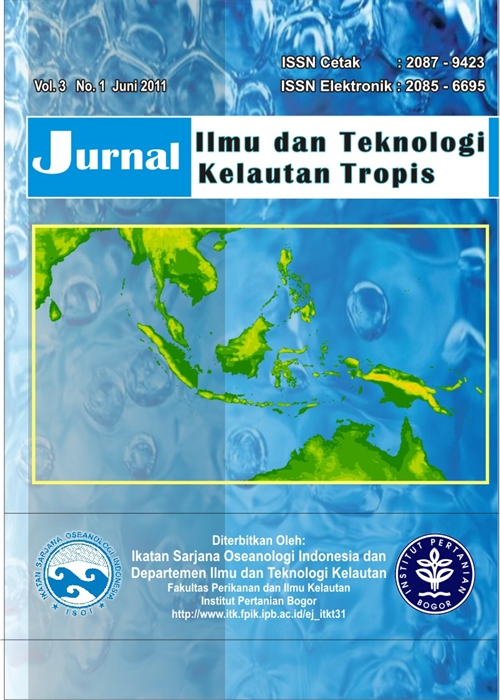SKIPJACK TUNA IN RELATION TO SEA SURFACE TEMPERATURE AND CHLOROPHYLL-A CONCENTRATION OF BONE BAY USING REMOTELY SENSED SATELLITE DATA
Abstract
Skipjack tuna is an important species targeting by pole and line fishery in Bone Bay. The distribution and abundance of this species tended to aggregate to the preferred bio-physical environments. To describe the short term relationship between skipjack tuna and oceanographic conditions and to visualize the predicted high catch areas, remotely sensed satellite based-oceanographic sea surface temperature (SST) and chlorophyll-a together fisheries data were used. Results indicated that the highest skipjack CPUEs were mainly found in coastal areas of Palopo and Kolaka both in 2007 and in 2009 during the period of study. The high tuna concentrations corresponded well with chlorophyll-a of 0.15-0.40 mg mg-3 and SST of 29.0-31.5 °C. The preferred ranges provide a good indicator for initially detecting potential skipjack fishing grounds. This study suggested that thermal and chlorophyll fronts as well as upwelling may important mechanisms in explaining the temporal and spatial dynamics of skipjack tuna distribution and abundance in Bone Bay.
Keywords: skipjack tuna, potential fishing grounds, satellite images and fronts
Authors
This work is licensed under a Creative Commons Attribution 4.0 International License.
Jurnal Ilmu dan Teknologi Kelautan Tropis i is an open-access journal, meaning that all content is freely available without charge to the user or their institution. Users are allowed to read, download, copy, distribute, print, search, or link to the full texts of the articles in this journal without needing to request prior permission from the publisher or the author.
All articles published by Jurnal Ilmu dan Teknologi Kelautan Tropis are licensed under the Creative Commons Attribution 4.0 International License. This allows for unrestricted use, distribution, and reproduction in any medium, provided proper credit is given to the original authors.
Authors submitting manuscripts should understand and agree that the copyright of published manuscripts is retained by the authors. Copyright encompasses the exclusive rights of authors to reproduce, distribute, and sell any part of the journal articles in all forms and media. Reproduction of any part of this journal, its storage in databases, and its transmission by any form or media is allowed without written permission from Jurnal Ilmu dan Teknologi Kelautan Tropis.


